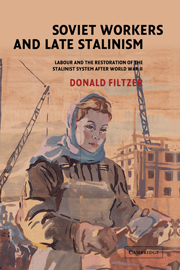 Soviet Workers and Late Stalinism
Soviet Workers and Late Stalinism Book contents
- Frontmatter
- Contents
- List of tables
- Preface and acknowledgements
- List of terms and abbreviations
- Introduction: the political imperatives of the postwar recovery
- 1 Rebuilding the workforce: free, slave, and indentured labour
- 2 The food crisis of 1946–1947
- 3 Attenuated recovery: the end of rationing, housing, and health
- 4 ‘Socializing’ the next generation: the position of young workers
- 5 Labour discipline and criminal law: the futility of repression
- 6 The industrial enterprise: working conditions, work organization, and wage determination
- Conclusion: labour and the ‘renormalization’ of Stalinist social relations
- Bibliography
- Index
Conclusion: labour and the ‘renormalization’ of Stalinist social relations
Published online by Cambridge University Press: 07 August 2009
- Frontmatter
- Contents
- List of tables
- Preface and acknowledgements
- List of terms and abbreviations
- Introduction: the political imperatives of the postwar recovery
- 1 Rebuilding the workforce: free, slave, and indentured labour
- 2 The food crisis of 1946–1947
- 3 Attenuated recovery: the end of rationing, housing, and health
- 4 ‘Socializing’ the next generation: the position of young workers
- 5 Labour discipline and criminal law: the futility of repression
- 6 The industrial enterprise: working conditions, work organization, and wage determination
- Conclusion: labour and the ‘renormalization’ of Stalinist social relations
- Bibliography
- Index
Summary
Let us begin by summarizing the book's main arguments. From there I move on to address some of the conceptual implications they have for my interpretation of postwar Stalinism and the legacy it bequeathed to Stalin's successors.
The nature of the postwar labour force. The Stalinist regime pursued a policy of rapid industrial recovery, which in turn demanded high rates of accumulation. Although the main shortage was in ‘capital’, that is, plant, equipment, fuel, and materials, there was a serious shortage of labour power in critical areas, most importantly, coal mining, construction, metallurgy, and transport. To satisfy their demand the regime had to mobilize millions of new workers. Many of them were slave labourers under the control of the MVD, but the regime relied even more heavily on semi-free or indentured labour. These workers came mainly from two sources: the Labour Reserve vocational schools, which conscripted most of its students from the countryside; and workers enlisted through so-called organized recruitment. They formed the core of the workforce in coal mining and construction, and for a brief period also iron and steel. These were key sectors of the economic recovery, yet they were also the sectors with the worst conditions and were heavily reliant on an unwilling workforce. All workers, however, faced severe restrictions on their freedom of action and movement. Leaving one's job without official sanction warranted a long sentence in a labour camp.
- Type
- Chapter
- Information
- Soviet Workers and Late StalinismLabour and the Restoration of the Stalinist System after World War II, pp. 245 - 265Publisher: Cambridge University PressPrint publication year: 2002


